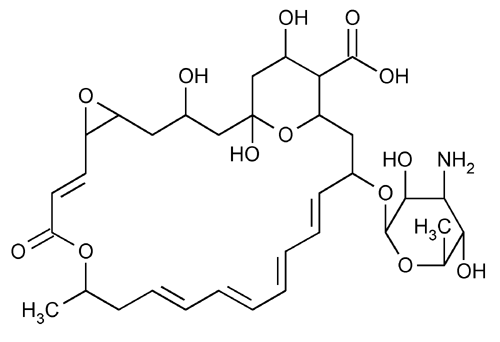Natamycin
Stereoisomer of 22-[(3-amino-3,6-dideoxy-
» Natamycin contains not less than 90.0 percent and not more than 102.0 percent of C33H47NO13, calculated on the anhydrous basis.
Packaging and storage—
Preserve in tight, light-resistant containers.
Identification—
Transfer 50 mg, accurately weighed, to a 200-mL volumetric flask, add 5.0 mL of water, and moisten the specimen. Add 100 mL of a 1 in 1000 solution of glacial acetic acid in methanol, and shake by mechanical means in the dark until dissolved. Dilute with the acetic acid-methanol solution to volume, and mix. Transfer 2.0 mL of this solution to a 100-mL volumetric flask, dilute with the acetic acid-methanol solution to volume, and mix: the UV absorption spectrum of the solution so obtained exhibits maxima and minima at the same wavelengths as that of a similar solution of USP Natamycin RS, concomitantly measured.
Crystallinity  695
695 :
meets the requirements.
:
meets the requirements.
pH  791
791 :
between 5.0 and 7.5, in an aqueous suspension containing 10 mg per mL.
:
between 5.0 and 7.5, in an aqueous suspension containing 10 mg per mL.
Water, Method I  921
921 :
between 6.0% and 9.0%.
:
between 6.0% and 9.0%.
Assay—
[note—Throughout the Assay, protect from direct light all solutions containing natamycin.]
Mobile phase—
Dissolve 3.0 g of ammonium acetate and 1.0 g of ammonium chloride in 760 mL of water, and mix. Add 5.0 mL of tetrahydrofuran and 240 mL of acetonitrile, and mix. Pass this solution through a 0.5 µm or finer porosity filter. Make adjustments if necessary (see System Suitability under Chromatography  621
621 ).
).
Standard preparation—
Transfer about 20 mg of USP Natamycin RS, accurately weighed, to a 100-mL volumetric flask. Add 5.0 mL of tetrahydrofuran, and sonicate for 10 minutes. Add 60 mL of methanol, and swirl to dissolve. Add 25 mL of water, and mix. Allow to cool to room temperature. Dilute with water to volume, and mix. Pass this solution through a suitable membrane filter of 0.5 µm or finer porosity.
Resolution solution—
Dissolve 20 mg of Natamycin in a mixture of 99 mL of methanol and 1 mL of 0.1 N hydrochloric acid, and allow to stand for 2 hours. [note—Use this solution within 1 hour.]
Assay preparation—
Transfer about 20 mg of Natamycin, accurately weighed, to a 100-mL volumetric flask. Proceed as directed under Standard preparation, beginning with “add 5.0 mL of tetrahydrofuran.”
Chromatographic system
(see Chromatography  621
621 )—The liquid chromatograph is equipped with a 303-nm detector and a 4.6-mm × 25-cm analytical column that contains packing L1. [note—A 3.9-mm × 20-mm pre-column may be used to extend the useful life of the analytical column.] The flow rate is about 3 mL per minute. Chromatograph the Standard preparation, and record the peak responses as directed for Procedure: the column efficiency determined from the analyte peak is not less than 3000 theoretical plates, the tailing factor is not less than 0.8 and not more than 1.3, and the relative standard deviation for replicate injections is not more than 1.0%. Chromatograph the Resolution solution, and record the peak responses as directed for Procedure: the resolution, R, between natamycin and its methyl ester is not less than 2.5. The relative retention times are about 0.7 for natamycin and 1.0 for its methyl ester.
)—The liquid chromatograph is equipped with a 303-nm detector and a 4.6-mm × 25-cm analytical column that contains packing L1. [note—A 3.9-mm × 20-mm pre-column may be used to extend the useful life of the analytical column.] The flow rate is about 3 mL per minute. Chromatograph the Standard preparation, and record the peak responses as directed for Procedure: the column efficiency determined from the analyte peak is not less than 3000 theoretical plates, the tailing factor is not less than 0.8 and not more than 1.3, and the relative standard deviation for replicate injections is not more than 1.0%. Chromatograph the Resolution solution, and record the peak responses as directed for Procedure: the resolution, R, between natamycin and its methyl ester is not less than 2.5. The relative retention times are about 0.7 for natamycin and 1.0 for its methyl ester.
Procedure—
[note—Use peak areas where peak responses are indicated.] Separately inject equal volumes (about 20 µL) of the Standard preparation and the Assay preparation into the chromatograph, record the chromatograms, and measure the responses for the major peaks. Calculate the percentage of natamycin (C33H47NO13) in the portion of Natamycin taken by the formula:
0.1(WSPS / WU)(rU / rS)
in which WS is the weight, in mg, of USP Natamycin RS taken to prepare the Standard preparation; PS is the stated content, in µg per mg, of USP Natamycin RS; WU is the weight, in mg, of Natamycin taken to prepare the Assay preparation; and rU and rS are the peak responses obtained from the Assay preparation and the Standard preparation, respectively.
Auxiliary Information—
Please check for your question in the FAQs before contacting USP.
Chromatographic Column—
| Topic/Question | Contact | Expert Committee |
| Monograph | Ahalya Wise, M.S.
Scientist 1-301-816-8161 |
(MDANT05) Monograph Development-Antibiotics |
| Reference Standards | Lili Wang, Technical Services Scientist 1-301-816-8129 RSTech@usp.org |
USP32–NF27 Page 3042
Chromatographic columns text is not derived from, and not part of, USP 32 or NF 27.
